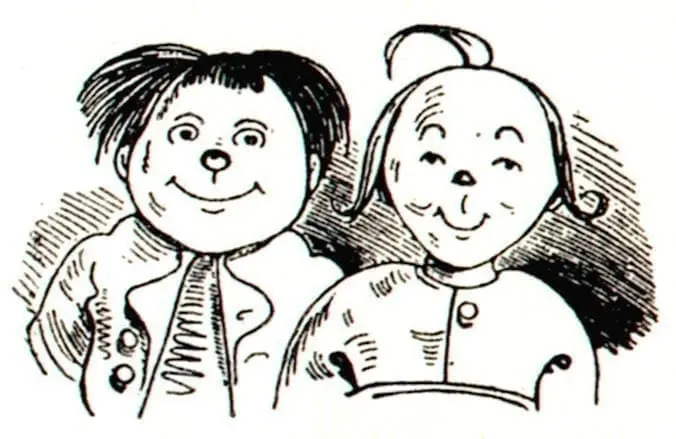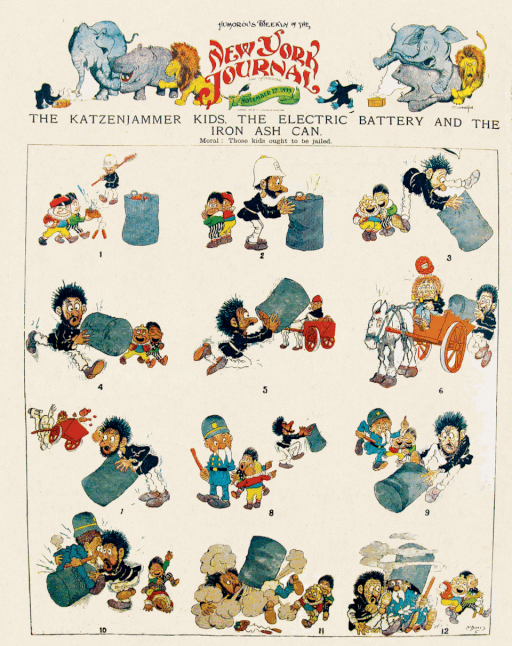On Dec.12, 1897 a comic strip featuring a German-American family with a distinctly Denglish accent made its first appearance in a Sunday Supplement of the New York Journal. The Katzenjammer Kids featured twins Hans and Fritz, two boys who were always up to mischief and pranks. The word Katzenjammer basically means “Cat Wailing” or caterwauling, and that loud yowling is a perfect name for these boys who are constantly causing trouble… and getting spanked for it! For over 100 years, the boys, along with their Mama, the Captain, and a host of other characters have traveled the world making us laugh. So how did this comic get started? And are Hans and Fritz really Max und Moritz in America?

Max und Moritz / Hans and Fritz
For those of us who grew up with Wilhelm Busch’s pranksters, Max und Moritz, the story may seem awfully familiar, and that’s not an accident. As a child, William Randolph Hearst already considered himself a collector. When his mother took him on grand tours of Europe, Hearst collected souvenirs along the way. In his later years he would gather up art or objects to fill his Castle above San Simeon, but as a child, Hearst collected toys and illustrated books.
The poet and artist, Wilhelm Busch is probably best known for his satirical verses alongside simple pen drawings. These picture stories or comic sketches were published as Bilderbogen… a precursor to today’s comic strips. This was a new way of telling a story, without a lot of words. Using this format, he wrote The Virtuoso, Didelbum!, Flips der Affe (Flip the Monkey), and hundreds of others, including his most famous story, Max und Moritz. This story, told in 7 parts, describes two bad boys causing mischief and mayhem, until they are finally caught, and come to a very bad ending. When Busch first took Max und Moritz to his publisher in 1865, it was rejected because the publisher doubted it would sell. Busch went back to Munich, and there Kaspar Braun paid him 1000 Gulden for the book (this equates to about 2 years salary, quite a bit of money for a satirist). Sales were slow, but eventually picked up, over the years hundreds of thousands of Max and Moritz books were sold… including one (almost certainly) to a young William Randolph Hearst.

As an adult, after cutting his teeth in the newspaper trade with the San Francisco Examiner, Hearst moved east, and bought the New York Journal in 1895. He remembered those boy pranksters from his childhood collection, and hired Rudolph Dirks, a German immigrant from Schleswig Holstein, to create a comic for his paper. The result… The Katzenjammer Kids.
The Katzenjammer Kids
The Katzenjammer Kids were supposed to be recent German immigrants who had not quite learned proper English. The goofy grammar and mixed up Denglish words were part of the charm. (Words like “chust” for “just”… “dat” for “that”). They played pranks, mostly on their parents, and were punished with spankings for their bad behavior. The comic’s characters changed a few times along the way. Originally, there were three boys… but one mysteriously went away (sort of like Richie’s older brother Chuck on Happy Days). Mama stayed, but Papa vanished… and was replaced by Der Captain, who eventually became Mama’s partner. Other characters like der Inspector and the Pirate joined the cast, but the stories were mainly about the boys.
Paul and Peter from the Tale of Plisch und Plum by Wilhelm Busch- From the book “The Genius of Wilhelm Busch” by Walter Arndt
You see they look like the original Katzenjammer Kids… and they get bent over a bench and spanked…just like Hans and Fritz.
Rudolph Dirks spent 15 years writing and drawing the Katzenjammer Kids. Along the way, Dirks changed how we read comics. For the first time, a comic strip had a story line with a specific cast of characters who readers got to know. He added movement to comic images… like that cloud of dust behind a running character. It was Dirk’s idea to use a circle of stars to indicate pain, and beads of sweat to let you know when someone was nervous. And most importantly, he invented the speech bubble.


So in 1914, Rudolph Dirks started a new comic strip called Hans und Fritz in the New York World. During World War I, due to anti-German sentiment, the name changed to The Captain and the Kids. Imagine two rival New York papers publishing comics with the same basic characters. Weirdly, both followed similar story arcs as well. For the next 50 years the Katzenjammer Kids drawn by Kerr, and Dirk’s Captain and the Kids traveled the world in parallel universes.

Harold Kerr, public Domain
100 years of Katzenjammer
The Katzenjammer’s weren’t immune to the anti-German sentiment of World War I. For 5 years their names were changed to Mike and Aleck… two Dutch brothers, before reverting back. By 1920, under Harold Kerr’s pen, the Katzenjammer Kids started to travel. They saw the Arctic and the Amazon. And they picked up a teacher, Miss Twiddle and her niece Luna, when they settled on the Squee-Gee islands off the coast of Africa. Hans und Fritz met Pirates and Natives. When Kerr died in 1949, the pen was passed to Doc Weissman, then Joe Musial. Today, the Katzenjammers are kept alive by Hy Eisman.
(Dirk continued drawing The Captain and the Kids, until he finally passed the strip to his son upon his death in 1968. The strip continued for another 11 years before coming to an end in 1979).
Over 100 years later, the Katzenjammer Kids is still in syndication, the longest running comic strip in America. And despite a stage play, and a silent movie, they never made the leap from comic strip to other media. Over time, the German-ness has faded away, but the pranks and silliness remain. Sure, there are more conversations instead of arguments, but at the heart, Hans and Fritz are still the same playful boys that Rudolph Dirks brought to life in 1897.
You can see the newest weekly strip here–> Katzenjammer Kids Comic
Katzenjammer: A Selection of Comics
References
How German Ingenuity Inspired America: More fun, More Beauty, More Freedom by Lynne Breene
The Genius of Wilhelm Busch bu Walter Arndt
http://www.toonopedia.com/katzen.htm
http://www.toonopedia.com/cap_kids.htm



